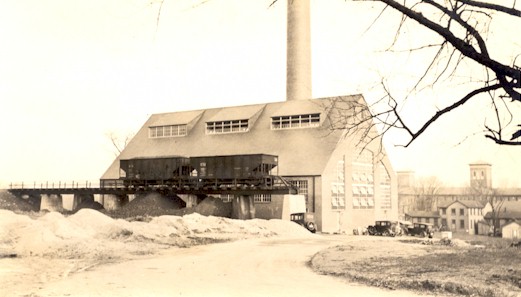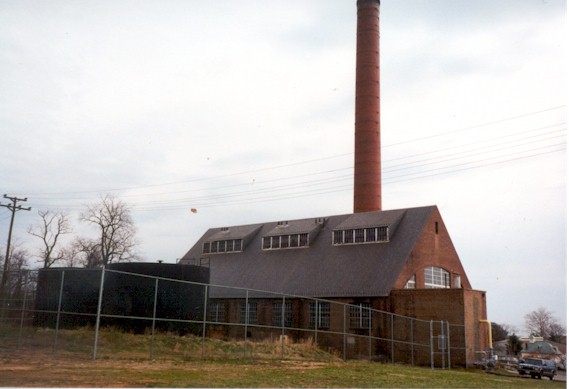The Power Plants at Spring Grove Hospital Center

The Spring Grove Power Plant, in the Early 1930's |

The Power Plant Today |
Built in 1932, the Spring Grove Hospital Center Power Plant generates steam that, through a network of underground conduits, provides heat and hot water to most of the 87 buildings on the Hospital Center's campus. Originally it was also the source of the hospital's electrical power and, at one time, it also housed chillers that produced large quantities of ice. (The ice was used for food refrigeration and, in the summer, blocks of ice were placed in front of electric fans to cool the patient-care areas.) The plant's boilers were converted from a coal-fired to an oil-fired system in 1970. Today, its boilers can be powered by either oil or natural gas. The elevated railroad tract seen in the earlier photograph was a spur of the Catonsville Short Line Railroad, a passenger and freight line that once ran along the western and northern edges of Spring Grove's property. (For those who are willing to risk getting poison ivy, portions of the rail bed and track can still be found in the wooded areas along the borders of the Spring Grove campus.) Coal was delivered to the Power Plant's automated stokers in cars that ran along the Catonsville Short Line.
Of note is the fact that Spring Grove's original (circa 1853) power house is also still standing. Today, that structure (shown below) is known as the Laundry Building. It was the original source of heat for the Main Building, and at one time it included a gas works that generated natural gas for the Main Building's gas lights. It also was the source of kinetic energy that was used, for example, to pump water. In 1896 an steam-powered electric generator was installed in the original power house. The power house was converted to a laundry after the 1932 Power Plant was built.

The Original Power House, early 1930s |

The Original Power House in 2000 |
Portions of the Main Building are shown to the left of the original Power House in the older photograph above. By the time that this photograph was taken, the Power House had been converted to the hospital's laundry -- a function that it continues to serve today. (Note that the smokestacks for the boilers had been removed by the time that the more recent photograph was taken.) When the Main Building opened in 1872 the plant's boilers produced steam that, in turn, was piped to a heat exchange system in the basement of the Main Building. The air that was heated by the steam-fed heat-exchanger was then funneled to the rest of the Main Buildings through a gravity-fed system. This gravity-fed hot air system proved to be unsatisfactory, and in 1899 it was converted to a forced hot-air system when blowers were installed to boost the delivery of the heated air to the upper floors of the building.

